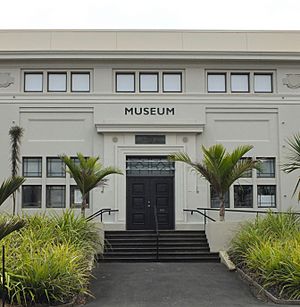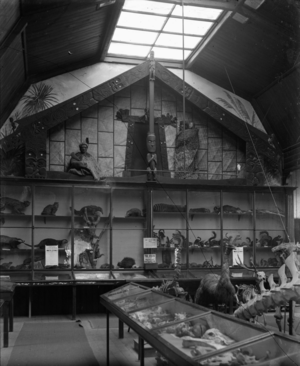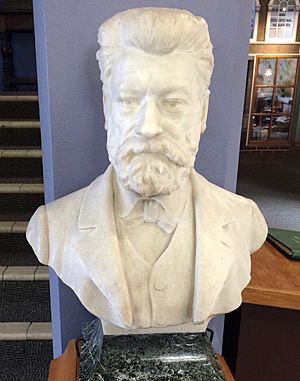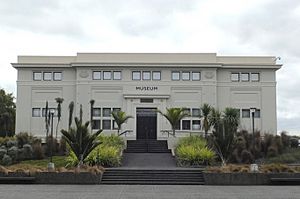Whanganui Regional Museum facts for kids
 |
|
| Former name | Wanganui Public Museum, Alexander Museum |
|---|---|
| Established | 1895 |
| Location | Whanganui, New Zealand |
| Collections | Natural history, taonga Māori, history |
| Collection size | 300,000 |
| Founder | Samuel Henry Drew |
The Whanganui Regional Museum in Whanganui, New Zealand, is a cool place to learn about nature and people. It has a huge collection of items that tell the story of the region. The museum also has important items from other parts of the world. These include beautiful Pacific tapa cloth, old pottery from Asia and Cyprus, and even moa bones from a nearby swamp.
Contents
History of the Museum
A local expert in nature and a jeweller named Samuel Henry Drew helped start the museum. His own private collection was bought by the town. He became the first honorary curator when the museum opened on March 24, 1895. Back then, it was called the Wanganui Public Museum. The first building was located where the Savage Club Hall is today.
The Alexander Museum Building
A new museum building was constructed in 1928. It was built on Watt Street, near Queen's Park. The architect, Robert Talboys, designed this building with two stories and a basement. The museum was renamed the 'Alexander Museum'. This new building was paid for with money from Henry Alexander's estate.
Moving to the new museum meant new things could be shown. Collections that were stored away could now be displayed. For example, the McLachlan collection of coins was put on show. A newspaper article from that time said this collection of British coins was the largest in the Southern Hemisphere. It included coins from Roman times all the way up to the 1920s. Three generations of the McLachlan family had collected these coins over 150 years. Other exhibits, like a three-meter-tall moa skeleton, were moved into storage.
In 1932, two prisoners who had escaped tried to hide in the museum. They pretended to be visitors. However, they looked messy and didn't seem interested in the displays. This made the director, J. Burnet, suspicious. He then recognized one of the men from a newspaper photograph.
Recent Changes and Upgrades
In 1968, the museum added a new section at the back. This was possible thanks to money from the Davis Trust. This new part included a Māori Court, a lecture theatre, a classroom, and a large multi-story car park. In 1997, the car park was changed into storage areas. These areas are used by the museum and the local council's archive department.
In September 2016, the museum closed to the public. This was so it could be made stronger against earthquakes and updated. During this time, exhibitions were held at the old Post Office building. The project cost $2.6 million. It was first planned to take 18 months. However, the reopening date was moved to October 2018, then January 2019. The museum finally reopened in March 2019.
Amazing Collections
Moa Bones and Eggs
The museum has a very important collection of moa bones. Many of these bones were found right in the local area. This is special because in other places, moa bones were often traded or spread out. In 1989, a scientist named Trevor Worthy studied and organized the moa collection. He was able to group the bones by age and species.
In the late 1890s, J. Burnet found a moa skeleton without a head in Wanganui East. The museum bought it, and R. Murdoch put it together. Twenty years later, a moa skull was found that fit the skeleton perfectly. In 1933, a large number of bones were discovered at Makirikiri. Five years later, the museum started a big dig with a budget of £1200. They used a crane, a bucket, and a sluice to find bones. About two thousand moa bones were found by hand-sorting through lots of mud. The curator, George Shepherd, put together ten skeletons from these bones, and they were put on display.
The museum's Curator of Natural History explained why this collection is so important. The Whanganui collection is one of the most important in the world. This is because it has stayed almost completely together. This allows scientists to study a whole group of moa that were trapped in the swamp over thousands of years. They can learn about their age, how fast they grew, their size, and how many males and females there were.
The museum also has a complete and unbroken moa egg. Workers found it in 1931 while digging a cliff at Waitotara. It is one of the very few complete moa eggs known in the world.
Māori Taonga (Treasures)
Part of the museum's Māori collection was given by Dr and Mrs Wall in 1933. This was a way to remember their son, John Barnicoat Wall. John had died in a climbing accident. To honor his interest in the museum, the Walls bought Dr. A.K. Newman's collection of Māori artifacts. They then donated it to the museum.
William James Harding Photo Collection
The William Harding photographic collection is a historic archive. It contains more than 6,500 photographs. These pictures show what Whanganui society was like from the 1850s to the 1880s. The collection is kept at the Alexander Turnbull Library and the Whanganui Regional Museum. In 2024, it was added to the UNESCO Memory of the World Aotearoa New Zealand Ngā Mahara o te Ao register. This means it is recognized as a very important part of the world's heritage.
Museum Directors
- Samuel H. Drew (1892–1901)
- J.H. Burnet (1930–1938)
- Max Smart (1951–1960)
- Donald Cimino (1973–1982)
- Brian Henderson (1982–1994)
- Sharon Dell (1995–2008)
- Wallis Barnicoat (2009–2010)
- Eric Dorfman (2011–2015)
- Frank Stark (2016–2019)
- Bronwyn Labrum (2021–)




